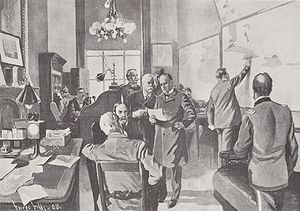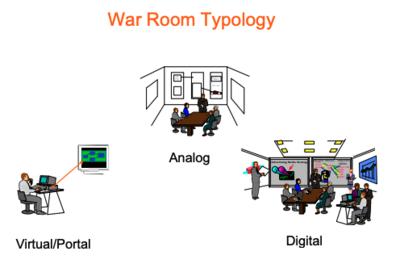Project War Rooms: Physical vs. Virtual
(→Physical Project War Rooms) |
(→Preparation) |
||
| Line 48: | Line 48: | ||
The skeleton of the room includes the following elements: | The skeleton of the room includes the following elements: | ||
| − | '1. Space for the entire project team' | + | ''1. Space for the entire project team'' |
A sea of information is never easy to digest. It is therefore important to categorise your war room into sections, such as | A sea of information is never easy to digest. It is therefore important to categorise your war room into sections, such as | ||
Revision as of 15:09, 13 March 2023
Written by Ellen Cathrine Luke
Abstract
Project war rooms are a crucial tool in project management. They allow for a group or team to have a visual and collaborative space to plan, strategize, and track progress. Historically, war rooms have been physical rooms, where teams would gather to work on the project together. However, due to the COVID-19 pandemic, increased amounts of remote work are arising and the format of war rooms has adapted to this change. Virtual war rooms have become increasingly popular, allowing team members to work together from different locations and still access all the necessary information and tools. Some of these virtual platforms are sourced by companies such as IBM and Microsoft[1]. With these virtual platforms, the challenge for project teams now becomes, “How do I provide that same data to the project team that we used to have in hard copy form in this room to the people no matter where they are on a real-time basis?”, as said IBM Project Manager Jerry Perone, PMP [2].
Despite the change in format, the importance of war rooms remains unchanged. They provide teams with a structured environment to tackle complex projects, and the visual nature of war rooms facilitates better communication and collaboration. In the post-pandemic world, virtual war rooms are becoming a necessity for organizations to manage their projects effectively, regardless of location. Both the physical and virtual format of a war room have their advantages and limitations, which will be explored further in the following sections.
Contents |
Introduction
Definition & Historical Overview of Project War Rooms

A Project War Room, also referred to as situation rooms, control rooms and command centers is a dedicated space or virtual platform where project teams can gather to visually plan and track the progress of a project. It is a collaborative environment where all stakeholders can have a clear understanding of the project's goals, tasks, and timeline [4] . The concept of project war rooms has existed for decades, particularly used throughout World War II and since the 1960’s. The concept has since been used in other contexts and has become an essential tool in project management [5].
Project war rooms were inspired by the military, where they would use the rooms to plan tactics and strategies to take down the enemy. Miniature models and figures would be laid out on tables, creating a visual and collaborative approach for leading generals. Since the later 1900’s, project war rooms became physical spaces, which were often located within an organization's headquarters. These would be set up as continuous spaces with walls covered in charts and information relevant to the project. The aim was to create a visual and interactive environment where the project team could work together, brainstorm, and make quick decisions [5].
Since the COVID-19 pandemic, the format of project war rooms has had to shift. Virtual war rooms have become increasingly popular, allowing team members to work together from different locations while still having access to all the necessary information and tools. The virtual environment provides the same collaborative and visual benefits as a physical war room, but with the added convenience of remote access [1].
Project war rooms allow organizations to manage their projects effectively, regardless of location, and are an essential tool in today's fast-paced and ever-changing business environment. Physical or virtual, project war rooms remain a critical tool in project management. They provide teams with a structured environment to tackle complex projects and the visual nature of war rooms allows for better communication and collaboration.
Physical Project War Rooms

The notion of a "war room" can at times be associated with a negative connotation. It expresses that a project is in crisis mode and not going as planned. A war room should instead be viewed as a "solution room", promoting active involvement from the team, hereby improving communication and collaboration. At the beginning of a project, several short- and longterm factors are unknown, but that does not mean they should be forgotten. Allocating physical or virtual space for collaborative planning helps to improve strategy development and will increase the chance of executing on time and on budget.
Preparation
War rooms can vary from being high-tech rooms with digital screens displaying information, to low-tech with whiteboards, post-it notes and hand written additions [5]. When setting up a physical war room, there are several key features that need to be addressed. The space should give the team overview and both show a broad and current state. It is therefore important to agree beforehand, how the war room is going to be used.
The overview should include daily, weekly, monthly, quarterly and even yearly progress and planning, in different degrees of detail. That means, the daily, weekly and monthly schedule should be more detailed than the long term overviews. Understanding the different layers of a project and maintaining the overview is crucial for project execution success.
The initial team should set out to create the skeleton of the room, whereafter experts are invited into the process adjust and assist[5]. Next, it needs to be decided whether or not a purely analog format is used, or if the idea of a hybrid war room is introduced. A hybrid version allows for the analog information on whiteboards and post-it notes to be translated into a digital platform afterwards. This makes the information easier to share with other stakeholders and generally more accessible.
The skeleton of the room includes the following elements:
1. Space for the entire project team
A sea of information is never easy to digest. It is therefore important to categorise your war room into sections, such as
1. Point of View: What is the goal of your project? (10%)
2. Input: Information such as references, research, current state (25%)
3. Building: Designs, prototypes, drawings, diagrams, etc. on what is actually going on currently within the project. This allows people to visualise and discuss current state. (35%)
4. Running: Highlight planning, schedules, roles through tools such as Scrum boards, canvases and road maps
5. Parking Lot: Unstructured or "homeless" information. New ideas can grow and and inspire. [6]
Creating a War Room
Advantages & Limitations
Advantages: Improved Communication and Collaboration, Increased Productivity, Clear Visuals,
Limitations: Limited Access, Higher Costs, Potential for unorganized room, Talking over one another
Virtual War Rooms
Key Features
(Digital Layout and Visualization, Bring in exampels from IBM and Microsoft (maybe others))
Preparation
Advantages and Disadvantages
Advantages: More Flexibility, Lower Costs, Allows for AI assistance (records meeting minutes, suggests new tasks)
Limitations: Limited Personal Interaction, Technical Challenges, Potential Miscommunication
NASA's implementation of a project war room in their Jet Propulsion Laboratory is an example to highlight. The design allowed for "extreme collaboration" and was able to boost productivity beyond the project managers expectations. Research also suggests that war rooms are most useful for teams whom have tasks that are interrelated
Conclusion
Summary & The Future of Project War Rooms
Growing Importance of Virtual War Rooms
Integration of Physical and Virtual War Rooms
Evolution of Project War Rooms
- ↑ 1.0 1.1 Barron, Robert. Solve problems in a virtual war room. Available at:https://www.ibm.com/garage/method/practices/manage/virtual-war-room/
- ↑ Ingebretsen, Mark. Enter the war room. Available at:https://www.pmi.org/learning/library/corporate-war-room-problem-solving-3368
- ↑ Naval History and Heritage Command, War Room, Available at: https://www.history.navy.mil/research/publications/documentary-histories/united-states-navy-s/telegraphy-and-cable/illustrations/war-room.html
- ↑ Kidd, Chrissy. What Is An “IT War Room”?, 2019, Available at:https://www.bmc.com/blogs/it-war-room/#:~:text=Also%20known%20as%20situation%20rooms,any%20type%20of%20project%20management.
- ↑ 5.0 5.1 5.2 5.3 5.4 Shaker, Steven, Lessons Learned from War Room Designs and Implementations, 2002, Available at: https://apps.dtic.mil/sti/pdfs/ADA467523.pdf
- ↑ Van Der Pluijm, Erik, "Welcome to the war room", Available at: https://designabetterbusiness.com/2016/12/02/welcome-to-the-war-room/